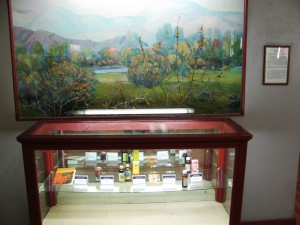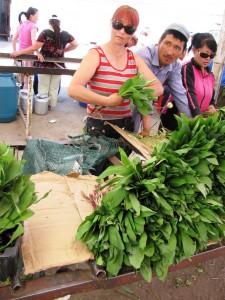 Speaking of weird fruits, Kuriositas has a great set of pictures of Citrus medica var. sarcodactylis, otherwise known as Buddha’s hand, for obvious reasons. My own contribution to the genre (at left) was snapped recently in Hanoi.
Speaking of weird fruits, Kuriositas has a great set of pictures of Citrus medica var. sarcodactylis, otherwise known as Buddha’s hand, for obvious reasons. My own contribution to the genre (at left) was snapped recently in Hanoi.
A different kind of pawpaw
WebEcoist has a nice series of slideshows on “70 Extremely Exotic Plants, Flowers, Forests & Trees.” Kinda silly, I know, but I’m a sucker for photos of weird plants, I guess. Anyway, the one on “Deliciously Exotic Plants, Fruits and Vegetables” puzzled me for a minute because the picture labelled “pawpaw” is certainly no Carica papaya. In my ignorance, I thought the term pawpaw was only ever used as a synonym for papaya. Well, it turns out the fruit in the picture is also called Hoosier banana, and is in fact Asimina triloba. Related to the cherimoya (Annona cherimola), “[t]he pawpaw is native to the temperate woodlands of the eastern U.S. The American Indian is credited with spreading the pawpaw across the eastern U.S. to eastern Kansas and Texas, and from the Great Lakes almost to the Gulf.” There’s a festival devoted to the fruit in Ohio in September. Interestingly, if you search Wikipedia for pawpaw, it sends you straight to Asimina. A Google search also returns mainly Asimina stuff, but if you search images you get a mixture of Carica and Asimina. The dangers of using common names.
Nibbles: Mangoes, Bees, Personalities, Business, Education, Meeting, Sorghum
- Mangofest in Miami. You missed it.
- Untreated seed saves bees? (Can someone please explain how this worked. If it worked.)
- Cary Fowler in the spotlight.
- IPCC envy? The Economist’s report on the Global Business of Biodiversity Symposium.
- “In seed time learn, in harvest time teach, in winter enjoy.”
- Ag experts descend on Ouagadougou for FARAweek. Hope springs eternal.
- Perennial sorghum?
Sea buckthorn becoming a success in a land with no sea
The name of the game in Mongolian agriculture is diversification. And one of the things researchers at PSARTI, the Plant Science Research and Training Institute in Darkhan, and others are looking at is a shrubby berry called sea buckthorn (Hippophae rhamnoides) with some interesting nutritional properties. They have put together a small germplasm collection of local and introduced material and are doing agronomic trials of various kinds, trying to find the best varieties for different purposes. In fact, the plant has a pretty long and rich history in Mongolia:
It is said that Genghis Khan, the Mongol conqueror, who established one of the largest empires from China to Eastern Europe in the 13th century, relied on three treasures: well organized armies, strict discipline and Seabuckthorn. Seabuckthorn berries and seed oil made Genghis Khan’s soldiers stronger than his enemies.
There are already some products on the market. Like this delicious icecream, called Ice Doctor.

The natural history museum in downtown Ulaanbaatar has a display featuring a number of locally-made products — a couple of different oils and “globules” — along with a somewhat threadbare diorama.

I guess commercialization still has some way to go, but a start has been made. Another wild species with some commercial potential may be strawberries.

Wild Allium of various kinds is also sold in the market.

Nibbles: Ecosystems, Coops, Cacao, Agroforestry
- Focus on ecosystem conservation: grasslands in South Africa, mangroves around the world.
- FAO says cooperatives are good for you.
- Great set of cacao photos from Sustainable Harvest International.
- Video Q&A on agroforestry with Dr Dennis Garrity, Director General of ICRAF.